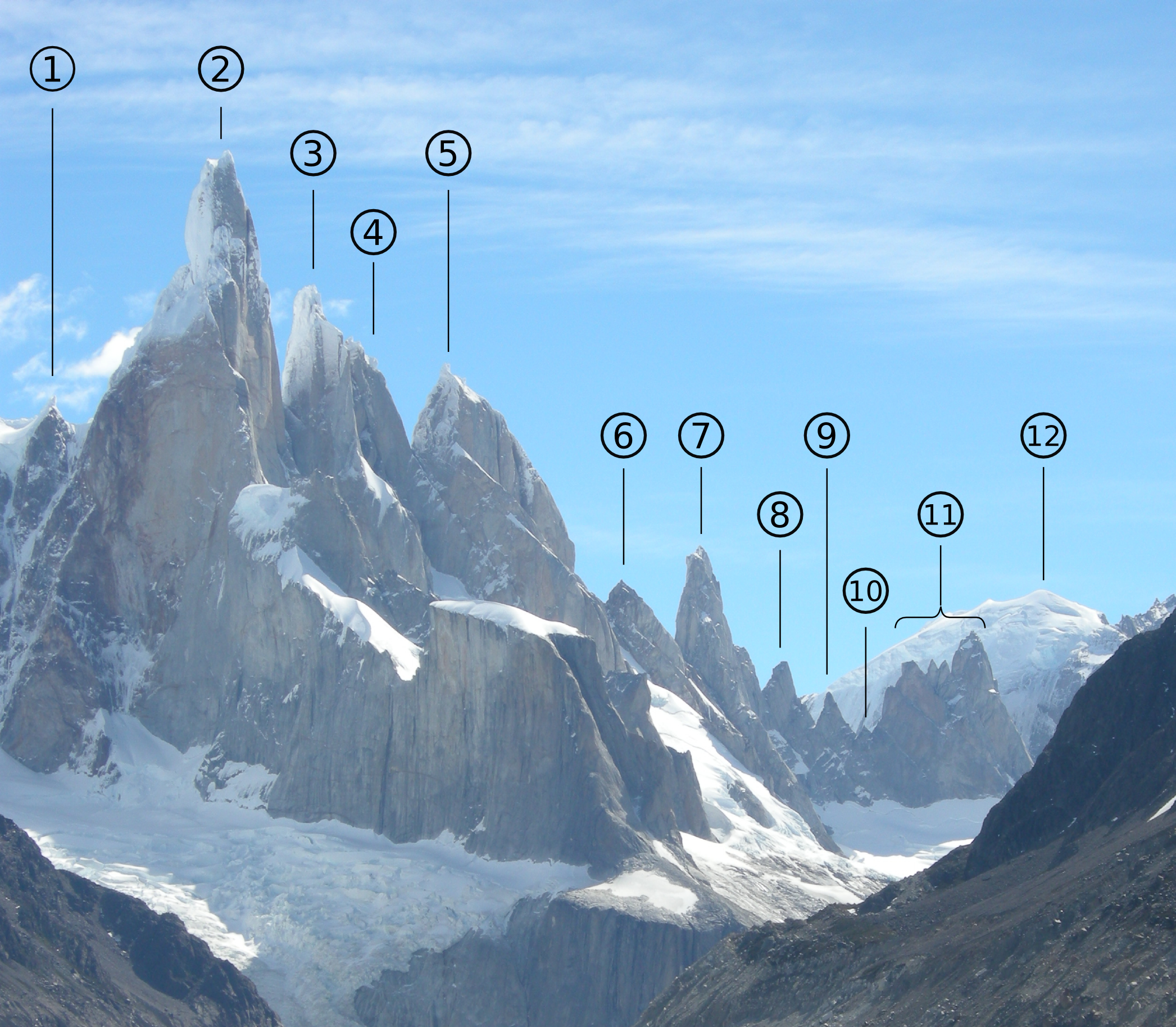|
Alpine Climbing
Alpine climbing () is a type of mountaineering that uses any of a broad range of advanced climbing skills, including rock climbing, ice climbing, and/or mixed climbing, to summit typically large routes (e.g. multi-pitch or big wall) in an alpine environment. While alpine climbing began in the European Alps, it is used to refer to climbing in any remote mountainous area, including in the Himalayas and Patagonia. The derived term alpine style refers to the fashion of alpine climbing to be in small lightly equipped teams who carry their equipment (e.g. no porters), and do all of the climbing (e.g. no sherpas or reserve teams). Alpinists face a wide range of serious risks in addition to the specific risks of rock, ice, and mixed climbing. This includes the risks of rockfalls (common with rock faces in alpine environments), avalanches (especially in couloirs), seracs and crevasses, violent storms hitting climbers on exposed mountain faces, altitude effects (dehydration, edema, f ... [...More Info...] [...Related Items...] OR: [Wikipedia] [Google] [Baidu] |
Rope Team
A rope team (sometimes also called moving together) is a climbing technique where two or more climbers who are attached to a single climbing rope move simultaneously together along easy-angled terrain that does not require points of fixed climbing protection to be inserted along the route. Rope teams contrast with simul-climbing, which involves only two climbers and where they are ascending steep terrain that will require many points of protection to be inserted along the route. A specific variant of a rope team is the technique of , which is used by mountain guides to help weaker clients, and which also does not employ fixed climbing protection points. Rope teams are commonly used in alpine climbing, particularly for moving across glaciers and traveling along snow slopes and ridges. Members are typically spaced apart with any surplus rope coiled and carried by the first and last members. The weaker members of the team are placed in the middle, however, it is important that ... [...More Info...] [...Related Items...] OR: [Wikipedia] [Google] [Baidu] |
Hermann Buhl
Hermann Buhl (21 September 1924 – 27 June 1957) was an Austrian mountaineer. His accomplishments include the first ascents of Nanga Parbat in 1953 and Broad Peak in 1957. Buhl is the father of Austrian-German writer, publisher, and freelance journalist, Kriemhild "Krimi" Buhl. Early life Buhl was born in Innsbruck, Austria, the youngest of four children. After the death of his mother, he spent years in an orphanage. Before , Hermann Buhl was a Cub Scout in Innsbruck. During the 1930s, as a teenager, he began to climb the Austrian Alps. In 1939, he joined the Innsbruck chapter of the Deutscher Alpenverein (the German Alpine association) and soon mastered climbs up to category 6. He was a member of the Mountain rescue team in Innsbruck (''Bergrettung Innsbruck''). World War II interrupted his commercial studies, and he joined the Alpine troops, as a mountain infantryman, in 1943. Buhl participated in the Monte Cassino, in Italy. After being taken prisoner by American tr ... [...More Info...] [...Related Items...] OR: [Wikipedia] [Google] [Baidu] |
Fitz Roy
Monte Fitz Roy (also known as Cerro Chaltén, Cerro Fitz Roy, or simply Mount Fitz Roy) is a mountain in Patagonia, on the border between Argentina and Chile.MONTE FITZ ROY ''Andes Hand Book, www.andeshandbook.org'', accessed 21 June 2021 /ref> ''www.interpatagonia.com'', accessed 21 June 2021 It is located in the Southern Patagonian Ice Field, near El Chaltén village and Viedma Lake. It was first climbed in 1952 by French alpinists Lionel Terray and :fr:Guido Magnone, ... [...More Info...] [...Related Items...] OR: [Wikipedia] [Google] [Baidu] |
Cerro Torre
Cerro Torre is one of the mountains of the Southern Patagonian Ice Field in South America. It is located on the border dividing Argentina and Chile, west of Fitz Roy (also known as Cerro Chaltén). At , the peak is the highest of a four mountain chain: the other peaks are Torre Egger (), Punta Herron, and Cerro Standhardt. The top of the mountain often has a mushroom of rime ice, formed by the constant strong winds, increasing the difficulty of reaching the actual summit. First ascent Cesare Maestri claimed in 1959 that he and Toni Egger had reached the summit and that Egger had been swept to his death by an avalanche while they were descending. Maestri declared that Egger had the camera with the pictures of the summit, but this camera was never found. Inconsistencies in Maestri's account, and the lack of bolts, pitons or fixed ropes on the route, have led most mountaineers to doubt Maestri's claim. In 2005, Ermanno Salvaterra, Rolando Garibotti and Alessandro Beltrami, after ... [...More Info...] [...Related Items...] OR: [Wikipedia] [Google] [Baidu] |
Baintha Brakk
__NOTOC__ Baintha Brakk () or The Ogre is a steep, craggy mountain, high, in the Panmah Muztagh, a subrange of the Karakoram mountain range. It is located in Gilgit-Baltistan, Pakistan.This region is disputed, and is claimed by India to be an integral part of the Indian state of Jammu and Kashmir. It is famous for being one of the hardest peaks in the world to climb: twenty-four years elapsed between the first ascent in 1977 and the second in 2001. Location Baintha Brakk rises above the north side of the Biafo Glacier, one of the major glaciers of the central Karakoram. It lies about north of Skardu, the major town of the region, and about north of the roadhead at Askole.''Orographical Sketch Map of the Karakoram'' by Jerzy Wala, 1990. Published by the Swiss Foundation for Alpine Research. Notable features Baintha Brakk is exceptional in its combination of altitude, height above local terrain, and steepness. It is a complex granite tower, steeper and rockier than mos ... [...More Info...] [...Related Items...] OR: [Wikipedia] [Google] [Baidu] |
Latok
The Latok () group is a cluster of large and dramatic rock peaks in the Panmah Muztagh, part of the central Karakoram mountain range in Pakistan. They lie just to the east of the Ogre group, dominated by Baintha Brakk. To the immediate south of the Latok group lies the Baintha Lukpar Glacier, a small tributary of the Biafo Glacier, one of the main glaciers of the Karakoram. On the north side, lies the Choktoi Glacier. The Latok range may be best known for Latok I's north ridge wall, which remains unclimbed in its entirety, despite many attempts. The Latok Tuber Belay Device, a piece of climbing equipment popularized by Jeff Lowe, takes its name from the mountain range. Latok group The Latok group comprises four main summits, each listed here with its relative position in the group, elevation, and first ascent date: * Latok I, north-central, 7,145 m, climbed 1979 * Latok II, west, 7,108 m, climbed 1977 * Latok III, east, 6,949 m, climbed 1979 * Latok IV, southeast, 6,456 m, cli ... [...More Info...] [...Related Items...] OR: [Wikipedia] [Google] [Baidu] |
Eight-thousander
The eight-thousanders are the 14 mountains recognized by the International Mountaineering and Climbing Federation (UIAA) as being more than in height above sea level, and sufficiently independent of neighbouring peaks. There is no precise definition of the criteria used to assess independence, and at times, the UIAA has considered whether the list should be expanded to 20 mountain peaks by including the major satellite peaks of eight-thousanders. All of the eight-thousanders are located in the Himalayas, Himalayan and Karakoram mountain ranges in Asia, and their summits lie in the altitude range known as the death zone. From 1950 to 1964, all 14 eight-thousanders were first summited by Expedition climbing, expedition climbers in the summer (the first to be summited was Annapurna I in 1950, and the last was Shishapangma in 1964), and from 1980 to 2021, all 14 were summited in the winter (the first to be summited in winter being Mount Everest in 1980, and the last being K2 in 2021 ... [...More Info...] [...Related Items...] OR: [Wikipedia] [Google] [Baidu] |
Enchainment
In mountaineering and climbing, enchainment (an anglicisation of the French language, French word , meaning "linking") is climbing two or more mountains or climbing routes on a mountain in one outing (often over the course of a day or a series of days). Rock climbing two or more routes in this manner are also called a "link up" in the United States. Climbers may do an enchainment of easy routes as a way of training for a more difficult objective, but some enchainments of hard routes are a prize in their own right, a notable example being the great north faces of the Alps. In alpinism By the 1970s, the number of possible new routes in the Alps seemed to be drying up, and so alpinists looked for other challenges. Developments in hang glider and paraglider technology, as well as advances in extreme skiing and the use of helicopters, meant that mountains could be descended much more quickly than they could by foot, making possible enchainments of long and difficult face routes. Early ... [...More Info...] [...Related Items...] OR: [Wikipedia] [Google] [Baidu] |
Gaston Rebuffat
Gaston is a masculine given name of French origin and a surname. The name "Gaston" may refer to: People First name *Gaston I, Count of Foix (1287–1315) * Gaston II, Count of Foix (1308–1343) *Gaston III, Count of Foix (1331–1391) *Gaston IV, Count of Foix (1422–1472) * Gaston I, Viscount of Béarn (died circa 980) * Gaston II, Viscount of Béarn (circa 951 – 1012) * Gaston III, Viscount of Béarn (died on or before 1045) * Gaston IV, Viscount of Béarn (died 1131) *Gaston V, Viscount of Béarn (died 1170) *Gaston VI, Viscount of Béarn (1173–1214) *Gaston VII, Viscount of Béarn (1225–1290) * Gaston of Foix, Prince of Viana (1444–1470) * Gaston, Count of Marsan (1721–1743) *Gaston, Duke of Orléans (1608–1660), French nobleman *Gastón Acurio (born 1967), Peruvian chef *Gaston Bachelard (1884–1962), French philosopher * Gaston Balande (1880–1971), French painter and illustrator * Gaston Borch (1871–1926), French composer, arranger, conductor, cellist and ... [...More Info...] [...Related Items...] OR: [Wikipedia] [Google] [Baidu] |
Riccardo Cassin
Riccardo Cassin (2 January 19096 August 2009) was an Italian Mountaineering, mountaineer, developer of Climbing equipment, mountaineering equipment and author, and an important figure in the history of rock climbing, alpine climbing and big wall climbing. Life Cassin was born into a peasant family at San Vito al Tagliamento in Friuli, in the kingdom of Italy. When he was three his father Valentino emigrated to Canada, where he died in a mining accident in 1913 when aged 29. Cassin left school at the age of 12 to work for a blacksmith. In 1926, at the age of 17, he moved to Lecco, where he found employment at a steel plant. His first love was boxing, but he soon became fascinated by the mountains that tower over Lake Como and Lake Garda.Riccardo Cassin ''The Telegraph''. 10 ... [...More Info...] [...Related Items...] OR: [Wikipedia] [Google] [Baidu] |
Walter Bonatti
Walter Bonatti (; 22 June 1930 – 13 September 2011) was an Italian people, Italian mountaineer, alpinist, explorer and journalist. He was noted for many climbing achievements, including a Solo climbing, solo climb of a new alpine climbing route on the south-west pillar of the Aiguille du Dru in August 1955, the first ascent of Gasherbrum IV in 1958, and, in 1965, the first solo climb in winter of the North face of the Matterhorn on the mountain's centenary year of its first ascent. Immediately after his solo climb on the Matterhorn, Bonatti announced his retirement from professional climbing at the age of 35, and after 17 years of climbing activity. He authored many mountaineering books and spent the remainder of his career travelling off the beaten track as a reporter for the Italian magazine ''Epoca''. He died on 13 September 2011 of pancreatic cancer in Rome aged 81, and was survived by his life partner, the actress Rossana Podestà. Famed for his climbing panache, he also pi ... [...More Info...] [...Related Items...] OR: [Wikipedia] [Google] [Baidu] |




